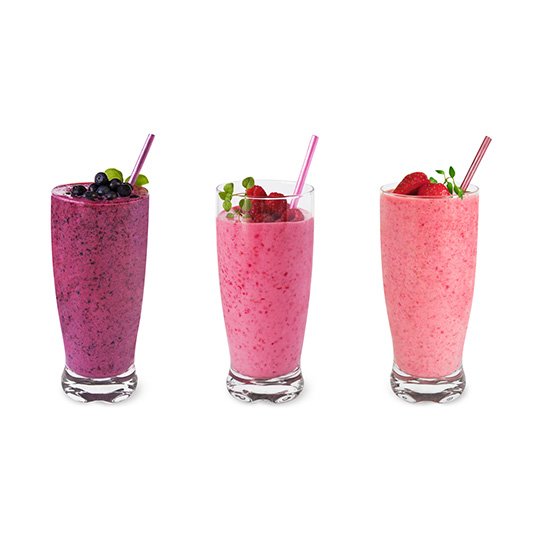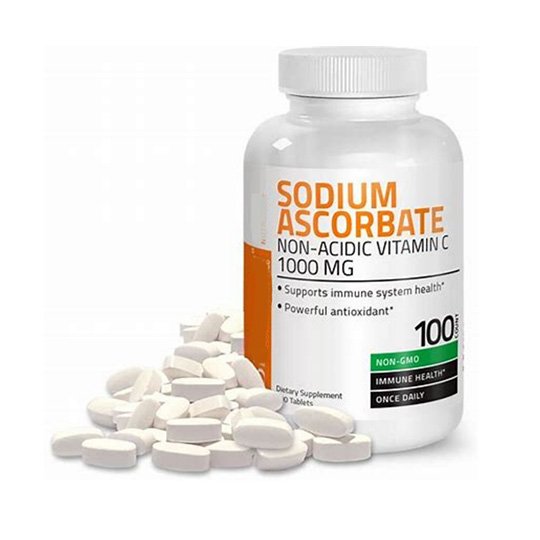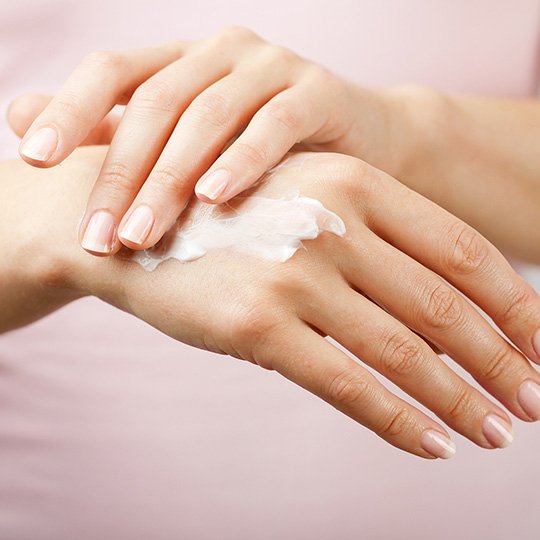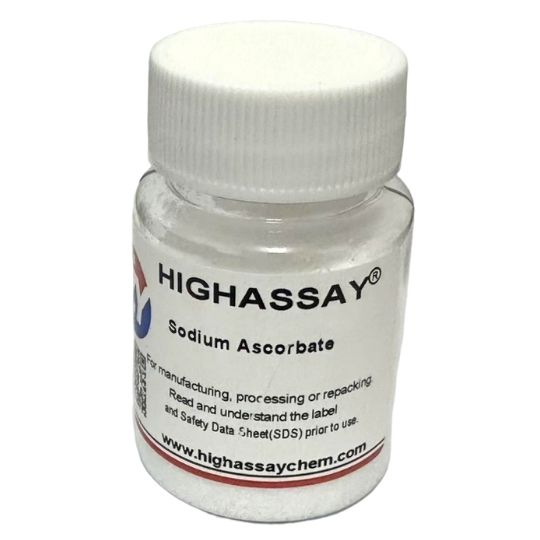What is Sodium Ascorbate
- Sodium ascorbate is the sodium salt of ascorbic acid (vitamin C). It comes in powder, crystals, or granules. It is a crystalline powder without any bitter or sour taste, fully reactive, and buffered.
- It combines 100% pharmaceutical-grade vitamin C and sodium in a highly soluble form, and its quality conforms to the standards of pharmacopeia (BP/USP/FCC/EP/E300).
- Vitamin C and sodium are important nutrients for your health. They act as powerful immune enhancers and antioxidants, helping to keep you strong and vibrant.
- HIGHASSAY Sodium Ascorbate adopts the most advanced “two-step fermentation method” production process and is produced, packaged, and stored following current Good Manufacturing Practices (cGMP). For all orders from sample quantities to commercial quantities, please contact us immediately!
Product by Grades
HIGHASSAY has been offering 2 different grades of sodium Ascorbate: pharmaceutical grade and food grade.
 Pharmaceutical Grade
Pharmaceutical GradePackage: 25Kg/carton.
Specification: USP/EP.
Usage: mainly used in the production of Vc-containing tablets, often replacing Vc in lozenges and effervescent tablets.
 Food Grade
Food GradePackage: 25Kg/carton.
Specification: FCC/E301.
Usage: mainly used as a food additive to act as a preservative, such as in canned food and bread.
Product by Forms
HIGHASSAY has been offering 2 different forms of sodium Ascorbate: Sodium Ascorbate powder and granule.
 Sodium Ascorbate Powder
Sodium Ascorbate PowderParticle size: 40、70、100mesh.
Package: 25Kg/carton, 500Kg/bag.
Specification: USP/FCC/EP/E301.
Usage: Formulation, like injection, and many other uses, like food additives.
 Sodium Ascorbate Granule
Sodium Ascorbate GranulePackage: 25Kg/carton.
Specification: In-house Standard.
Usage: Direct compression into tablets.
Application of Sodium Ascorbate

- Antioxidants: Prevent food from oxidizing and deteriorating, and extend the shelf life (such as meat, juice, canned food, etc.).
- Nutritional fortifiers: Supplementing vitamin C to enhance the nutritional value of foods (such as beverages, milk powder, grains, etc.).
- Color stabilizer: Maintains the natural color of processed foods (such as fruit and vegetable products).
- Acidity regulator: It gently regulates the pH value of food, is more stable than ascorbic acid (vitamin C), and has less irritation.

- Vitamin C supplements: Used for preventing or treating vitamin C deficiency (such as scurvy), and enhancing immunity.
- Buffered Vitamin C: It is milder than ordinary Vitamin C (acidic) and is suitable for people with sensitive stomachs.
- Adjuvant therapy: Promotes collagen synthesis and aids in wound healing; enhances iron absorption (when used in combination with iron supplements).

Antioxidant: Neutralizes free radicals and delays skin aging (commonly found in serums, creams, etc.).
Brightening and Lightening Skin: Inhibiting melanin production and enhancing skin brightness.
Stable formula: As a mild pH regulator or auxiliary preservative ingredient.

- Experimental reagents: Used for biochemical research or as reducing agents.
- Aquaculture: As an additive for animal feed, it promotes growth and immunity.
Information Sheet
| Product Name | Sodium Ascorbate |
| CAS NO. | 134-03-2 |
| Synonyms | L-Ascorbic Acid Sodium Salt, Vitamin C sodium salt, (+)-Sodium L-ascorbate, Monosodium L-Ascorbate |
| Molecular Formula | C6H7NaO6 |
| Molecular weight | 198.1059 |
| Package | 20kg/carton, 25kg/drum |
| shelf life | 4 years |
Specification
| Specification | BP/USP/FCC/EP/E300 |
| Characteristics | White or almost white crystalline powder or colourless crystals |
| *Solubility | Freely soluble in water, slightly soluble in ethanol, insoluble in chloroform |
| Identification A | Positive reaction |
| *Identification B | IR |
| Melting point | About 190℃ |
| Specific rotation | +20.5°~+21.5° |
| pH(5%,W/V) | 2.1~2.6 |
| *pH(2%,W/V) | 2.4~2.8 |
| *Loss on drying | ≤0.1% |
| Residue on ignition | ≤0.1% |
| Assay | 99.0%~100.5% |
| Clarity of solution | Clear |
| Color of solution | ≤BY₇ |
| *Impurity E | ≤0.2% |
| *Impurity C | ≤0.15% |
| *Impurity D | ≤0.15% |
| *Unspecified impurities | ≤0.10% |
| *Total of impurities other than C and D | ≤0.2% |
| *Heavy metal | ≤10ppm |
| *Copper | ≤5ppm |
| *Iron | ≤2ppm |
| *Cadmium(ICP-MS) | ≤1ppm |
| *Mercury(ICP-MS) | ≤1ppm |
| *Lead(ICP-MS) | ≤lppm |
| *Arsenic(ICP-MS) | ≤lppm |
| *Total Plate Count | ≤1000cfu/g |
| *Yeast and Molds | ≤100cfu/g |
| *Escherichia coli | Negative |
| *Salmonella | Negative |
| *Staphylococcus Aureus | Negative |
| *Residual solvents | Meets requirement |
Both vitamin C and sodium ascorbate are suitable for use in vitamin C supplementation. Both are excellent antioxidants and help enhance immune health.
However, since ascorbic acid is an organic acid and not in a buffered state, this form of ascorbic acid may stimulate the digestive system. It causes the pH value in the stomach to rise and may trigger excessive stomach acid production in those with hyperchlorhydria, leading to acid reflux, heartburn, nausea, and an unpleasant taste.
VC-Na has a neutral pH, causing less irritation to the gastrointestinal tract. Moreover, as it is a sodium salt, it has better water solubility and thus is more stable in performance and easier to absorb. Compared with VC, VC-Na can also provide a small amount of sodium, approximately 11% of the sodium content.




